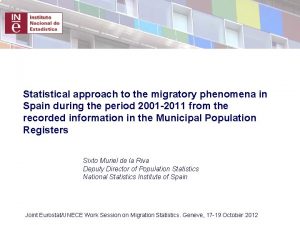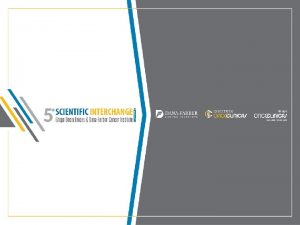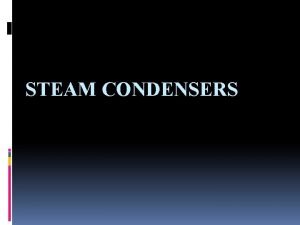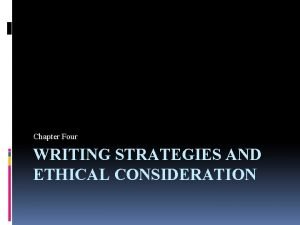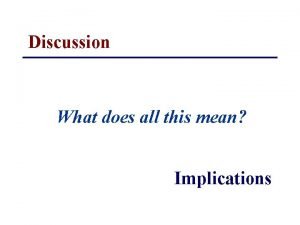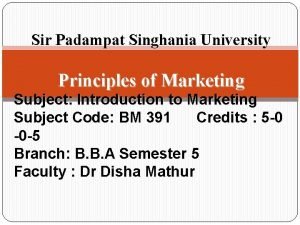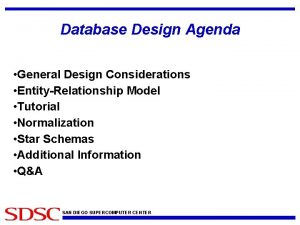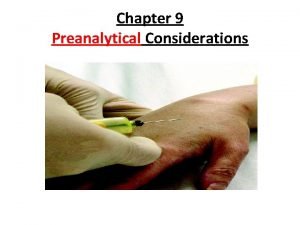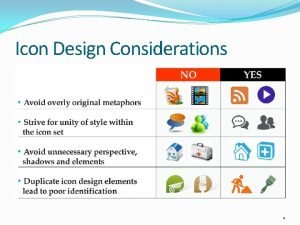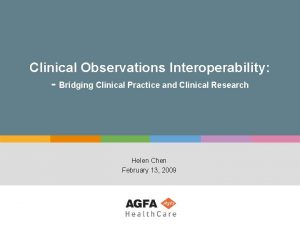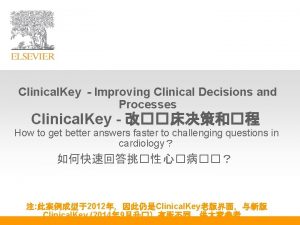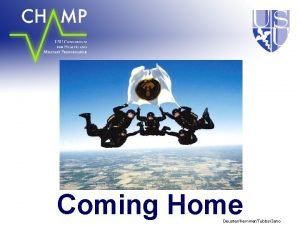Coming Out Considerations and clinical implications Sixto Muoz






























- Slides: 30

Coming Out: Considerations and clinical implications Sixto Muñoz, LICSW Developed with help by Rhonda Linde, Ph. D, Ana Maldonado, PA-C, MPH, DHSc & Melissa Savage, LICSW, LADC

Cultural Competence “a heightened consciousness and analytic grasp of how race and ethnicity, gender and sexual orientation, social class and status, religion and spirituality, age, and development stage, as well as physical or mental abilities affect the lives of people and their environments” (NASW, 2001)

6 themes in an LGBTQ-affirming practice approach: Attitudes 1. Same gender sexual desires and behaviors are viewed as a normal variation in human sexuality 2. The adoption of a LGBTQ identity is a positive outcome of any process in which an individual is developing a gender or sexual identity.

6 themes in an LGBTQ-affirming practice approach: Knowledge 3. Service providers should not automatically assume a client’s sexual orientation or gender identity. 4. It is important to understand the coming out process and its variations. Skills 5. Practitioners need to be able to deal with their own racism, sexism, biases and queerphobia. 6. When assessing a client, practitioners should not automatically assume that the client is heterosexual, male or female.

LGBTQ Sensitive Therapy: Creating a non-judgmental atmosphere • Photos, pictures in office: who do they include/exclude • Explore own feelings that might result in unconscious bias • Use neutral language eliminate assumptions of heterosexuality

Sexual Orientation/Gender Identity may not be the presenting problem • Do not over-treat or under-treat their sexuality • Do not assume that sexual orientation/gender identity is the presenting problem • Do not assume that it has no impact on their mental health

Impact of Stigma & Discrimination on Mental Health • Constant concealment of true identity (“Covering”) • Fear of, or actual victimization by, verbal or physical attack • Social isolation/ lack of social supports • Problems with self-acceptance • Stigma and pressures to be gender-conforming may affect personality development • Social determinants of health may shape one’s developmental processes, self-esteem, and selfconcept.

Impact of Stigma & Discrimination on Mental Health, Cont • Stressors that are physical, emotional, cultural, spiritual and/or other stressors (e. g. , financial problems as a result of employment discrimination) interfere with ability to achieve goals. • Insensitive, inattentive, uninformed, and inadequately trained and supervised care providers compound stigma • Stigma, oppression and discrimination contribute to psychological symptoms, but do not necessarily indicate pathology • Elevated rates of depression, smoking, drug and alcohol abuse among LGBTQ people

Coming out: 3 models Sexual Identity: The Cass Model (1979) • One of foundational theories of gay and lesbian development • Sequential theory of development with 6 stages

Coming out: 3 Models The Cass Model (1979) Identity Awareness Identity Comparison Identity Tolerance Identity Acceptance Identity Pride Identity Synthesis

Coming out: 3 models Anthony D’Augelli: “Homosexual Lifespan Development Model” • Developed in 1994, this model does not use a stages perspective, but rather is focused on processes that could occur repeatedly or not at all. Acknowledging that LGBTQ people are coming out process repeatedly across their lifespan. This model also recognized that LGBTQ identity development could stop, then start again—or begin when a person perceives that it would be safe to come out.

Coming out: 3 models

Coming out: 3 models Arlene Istar Lev “Transgender Emergence Model” • Developed in 2004, this 6 stage model is written not only from the point of view of the individual, but also of the clinician and describes ways trans people come to view their identity.

Coming out: 3 Models Lev – Transgender Awareness Exploration Model (Transition Awareness Seeking Info/Reaching Out Exploration (Identity and Self-labeling) Issues & Possible Body Modification) Disclosure to Significant Others Integration (Acceptance & Post. Transition Issues)

LGBTQ Development: Adolescence/Youth • Lack of opportunity to experiment with LGBTQ identity due to antipathy of peers, family & society • May be few age-appropriate activities/institutions available to LGBTQ youth • Stress of homophobia/transphobia can lead to increased risk/self destructive behaviors (suicidality, substance abuse, tobacco use, pregnancy) when compared to their heterosexual/cisgender peers https: //www. youtube. com/watch? v=IRLSg. PQG 0 c 4

LGBTQ DEVELOPMENT: Young Adulthood/Middle Age • Many LGBTQ people develop a positive sense of self and form satisfying relationships • Some are distressed by being LGBTQ and may repress/suppress it • Delay of interpersonal tasks from adolescence:

Challenges for Older LGBTQ People • May revisit some of the conflicts from adolescence if need to retire to straight retirement/nursing homes where homo/transphobic stigma may again isolate & inhibit them • May retreat into safety of invisibility • May be vulnerable to decisions of blood family members who may have legal power. • Ageism in the LGBTQ community

Helping a Client decide about Coming Out • Evaluate possibility for negative reactions – rejection, harassment, discrimination, anti-LGBTQ violence • Evaluate possible gains – feeling more authentic, not having to hide a major part of oneself, increase of intimacy via self-disclosure/sharing of life events, receiving support, finding community, consolidating identity • Explore: internalized transphobia, homophobia, sexism, consequences of bending traditional gender roles, loss of acceptance, and lack of societal support

Factors to consider during an evaluation or treatment Presenting Problem Is it LGBTQ-related or not? Presenting Problem- Substance Abuse • Substance Abuse & Coming Out: – Does client frequent bars? – Are they part of the party circuit or find hook ups on-line? – Do they use substances to engage in sex? – Are they involved with AA/NA?

Factors to consider during an evaluation or treatment Social History & Functioning • History of friendships: same/opposite sex • Participation in group activities: sports, other Assess sex role stereotypes of activities & in friendships (identified with same or opposite-gender sex roles? ) • Sense of isolation: was there any scapegoating/teasing/ harassment/beating because of perception the client was LGBTQ? • Any relationship that was a support or a safe haven? • Any LGBTQ role models growing up?

Factors to consider during an evaluation or treatment Social History & Functioning • Current social networks: LGBTQ groups/activities • Who are they out to? At work, friends, family? • Do they have LGBTQ friends? Straight friends? History of primary romantic relationships: • With cismen/women (natal), transmen/women? • Assess patterns and themes in relationships, role of substances, sex. • Were they satisfying or abusive relationships?

Factors to consider during an evaluation or treatment Vocational/Educational History • Ask to whom are they out at work • How trans/homophobic is the work environment? • Any other LGBTQ people at their place of work? • Was/is there pressure to date heterosexually in school? • Was/is school work affected by struggles re: coming out or by society's homo/bi/transphobia?

Factors to consider during an evaluation or treatment Sexual History & Functioning • First sexual attractions, fantasies and encounters: same/different gender: – How comfortable were they with these? • Were sexual experiences: – In the context of an on-going relationship? – One night stands or anonymous? – Were substances involved? – How did they feel after?

Factors to consider during an evaluation or treatment Sexual History & Functioning • Sexual behavior: – Assess degree of safer sex – Knowledge of STD transmission – Use of substances? • Assess presence/degree of sexual compulsivity • Role of sex/sexuality in life and in sense of self

Factors to consider during an evaluation or treatment Impact of Stigma/Discrimination on Gay Male Sexuality • Due to historical stigma and fear: – contact with other gays had to be a furtive act – Few non-sexual institutions before AIDS – Sex was first contact point to meet others Psychological Functions of Casual/Anonymous Sex for some gay men For some it is a recreational part of well-adjusted life For some it is: • Compulsive • For some men who lead a closeted, split life (married heterosexually), anonymous sex is the only way to be with men without risking social exposure

Factors to consider during an evaluation or treatment Medical History • Experience with transphobia/homophobia in healthcare – Uncomfortable revealing gender identity/sexual orientation/behavior to a medical provider? – Avoidance of medical care or withholding of information from a provider for fear of harassment/discrimination?

Helping a Client decide about Coming Out Online Resources: • It Gets Better Project: http: //www. itgetsbetter. org/ - created by Dan Savage in 2010 as a response to LGBTQ youth suicide • RUComing Out: http: //www. rucomingout. com – created in 2012 as an online support for closeted people to read stories from other’s across the world about their coming out experience • Human Rights Campaign, Resource Guide: http: //www. hrc. org/resources/resource-guide-to-comingout - nation’s largest LGBTQ civil right’s organization

Questions? • ?

References • • • Cass, V. C. (1979). Homosexual identity formation: A theoretical model. Journal of Homosexuality, 4, 219 -235. D'Augelli, A. R. (1994). “Identity development and sexual orientation: Toward a model of lesbian, gay, and bisexual development. ” Diplacido, J. (1998). Minority stress among lesbians, gay men, and bisexuals: A consequence of heterosexism, homophobia, and stigmatization. In G. Herek (Ed. ), Psychological Perspectives on Lesbian and Gay Issues: Stigma and sexual orientation: Understanding prejudice against lesbians, gay men, and bisexuals. (pp. 138 -160). Thousand Oaks, CA: SAGE Publications, Inc. doi: http: //dx. doi. org/10. 4135/9781452243818. n 7 Lev, A. I. (2004). Transgender Emergence: Therapeutic guidelines for working with gender-variant people and their families. Binghamton, NY: Haworth Press. National Association of Social Workers. (2001). NASW standards for cultural competence in social work practice. Social Work Speaks. 1996 NASW Delegate Assembly. Savin-Williams, Ritch C. (1994). Verbal and physical abuse as stressors in the lives of lesbian, gay male, and bisexual youths: Associations with school problems, running away, substance abuse, prostitution, and suicide. Journal of Consulting and Clinical Psychology, 62(2), 261 -269. https: //safezone. uncc. edu/allies/theories http: //www. hrc. org/resources/resource-guide-to-coming-out http: //www. itgetsbetter. org/ http: //www. rucomingout. com/

References • • https: //safezone. uncc. edu/allies/theories http: //www. hrc. org/resources/resource-guide-to-coming-out http: //www. itgetsbetter. org/ http: //www. rucomingout. com/
 Sixto and bening
Sixto and bening Gepar
Gepar Sixto muriel de la riva
Sixto muriel de la riva Gepar sixto
Gepar sixto You're my kryptonite you keep making me weak
You're my kryptonite you keep making me weak Letter to my parents
Letter to my parents In shell and tube surface condenser
In shell and tube surface condenser Writing strategies and ethical considerations
Writing strategies and ethical considerations Ethical consideration in experimental research sample
Ethical consideration in experimental research sample Pricing considerations and approaches
Pricing considerations and approaches Discussion and implications
Discussion and implications Who says put out the light and then put out the light
Who says put out the light and then put out the light What are the general considerations in machine design
What are the general considerations in machine design Tax considerations for setting up a new business
Tax considerations for setting up a new business Emv kiosk considerations
Emv kiosk considerations Three considerations of societal marketing concept
Three considerations of societal marketing concept Mechanical design of transmission line
Mechanical design of transmission line Database design considerations
Database design considerations Psychomotor considerations language acquisition
Psychomotor considerations language acquisition What is cloud delivery model
What is cloud delivery model Chapter 9 pre examination/preanalytical considerations
Chapter 9 pre examination/preanalytical considerations Bioreactor considerations for animal cell culture
Bioreactor considerations for animal cell culture Collaboration design considerations
Collaboration design considerations Axial reduction in fpd
Axial reduction in fpd Antecubial region
Antecubial region Biopharmaceutic considerations in drug product design
Biopharmaceutic considerations in drug product design Parts of alveololingual sulcus
Parts of alveololingual sulcus Dogso spa
Dogso spa Design considerations icon
Design considerations icon Fluid intake pdhpe
Fluid intake pdhpe Gastrectomy anesthesia considerations
Gastrectomy anesthesia considerations


